Industrial import price index overview
Data extracted in May 2024.
Planned article update: May 2025.
Highlights
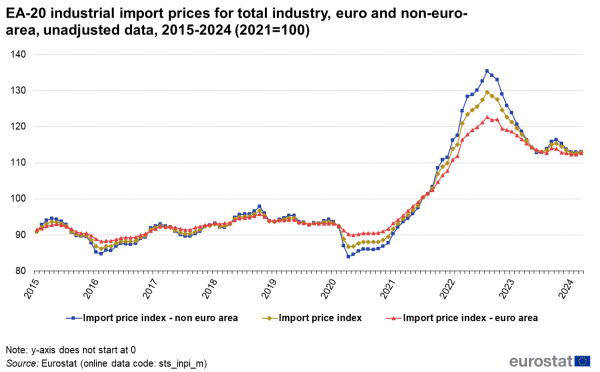
The industrial import price index (abbreviated as IMPR or sometimes MPI) is a business cycle indicator which measures monthly price changes of products which are imported by domestic businesses from other countries.
According to the European business statistics regulation only countries in the euro area are obliged to transmit import prices to Eurostat. However several non-euro-area countries in the European Union (EU) and even some EFTA countries provide this information as well.
The indices for import prices are calculated with a distinction between imports coming from within or outside the euro area.
Full article
Import prices for total industry
In the spring of 2015, a decrease in import prices set in which lasted until early 2016, when prices began to steadily rise again. In general, however, import prices remained rather stable between 2015 and 2020. During the first wave of the COVID-19 pandemic, import prices dropped sharply (-5.7 % between February and April 2020) but started to go up again in the second half of 2020. During 2021 and 2022, there was quite a dramatic increase that peaked in the summer of 2022. Between the summer of 2022 and the summer of 2023, prices were on a steep downward trend without coming back to the historical levels. In recent months import prices appear to have stabilised (Figure 1).

Import prices according to main industrial groupings (MIGs)
For the different main industrial groupings price developments were relatively heterogeneous (Figure 2). During the peak of the COVID-19 crisis, i.e. between February and April 2020, import prices for intermediate products and for non-durable consumer goods dropped. The magnitude of the reductions was, however, very moderate. The import prices for energy products, however, were almost halved, leading to a total reduction in the index of import prices of more than 6 % between February and April.
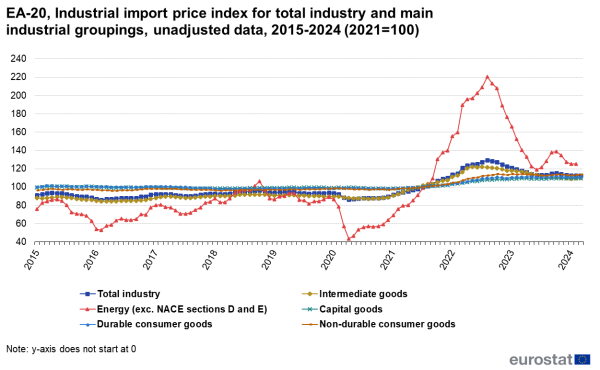
Prices for capital goods, for durable and non-durable consumer goods remained relatively stable for several years between 2015 and the second half of 2021, when they started a steady but comparatively moderate increase. In general, intermediate goods show a similar pattern as total industry. They remained quite stable between 2015 and 2020 and started to rise in 2021. The upwards trend lasted until early summer of 2022, when prices began to fall. At present they are, however, still at a relatively elevated level.
Import prices for energy products (which constitute around 12 % of the total euro area index) are much more volatile than the prices for the other product groups. In the second half of 2015, import prices dropped significantly. During the following three years energy prices went up again. In 2019, prices began to fall and between December 2019 and April 2020, i.e. during the first wave of the COVID-19 pandemic, energy prices fell sharply. Since then these prices have increased in a way that has never before been recorded, reaching a peak level in August 2022 that was about three times as high as the long-term average of these prices. Between September 2022 and the summer of 2023, import prices for energy fell in the same dramatic way in which they had risen before but the former lower levels of the index were not regained. During the second half of 2023, energy prices showed again a temporary increase. Currently the index level of these prices is about 60 % higher than before the COVID-19 crisis.
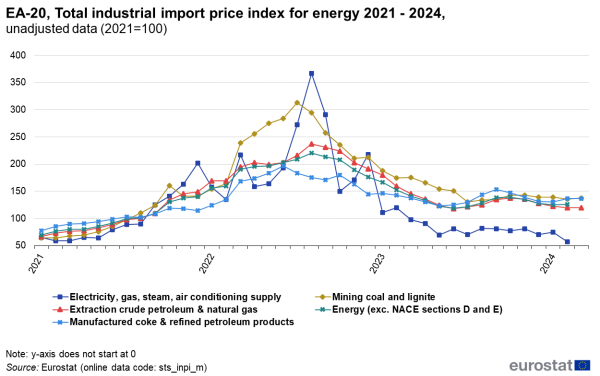
Figure 3 highlights the recent development regarding the total import price index for the various energy industries between January 2021 and February/March 2024. In the first half of 2021, the growth of energy prices was already quite pronounced when compared with the long term development since 2010. In the second half of 2021, however, especially between September and November and in the first months of 2022, import energy prices reached unprecedented growth rates. Between the summer of 2021 and 2022, energy prices more than doubled. Prices for electricity increased by more than 300 % Since August 2022, energy prices have fallen rapidly (-43 %) yet, with the exception of prices for electricity, gas, steam and air conditioning supply, the current price index levels are still much higher than ever recorded before.
Annual changes
In all countries for which data are available, total import prices show similar up-and-down-patterns. In 2015 and 2016, import prices in almost all Member States of the euro area registered a negative annual growth rate but regained positive growth rates in 2017 and in 2018. In 2019, prices dropped in quite a number of countries. In 2020, prices dropped in all countries for which data are available. For 2021, the general trend was quite clear, growth rates were generally at a two-digit level and higher than ever before. In 2022, this development was continued with even higher price increases, often at a level of 25 % or more. In 2023, prices fell in almost all countries. These decreases were, however, much smaller than the previous increases (Table 1).
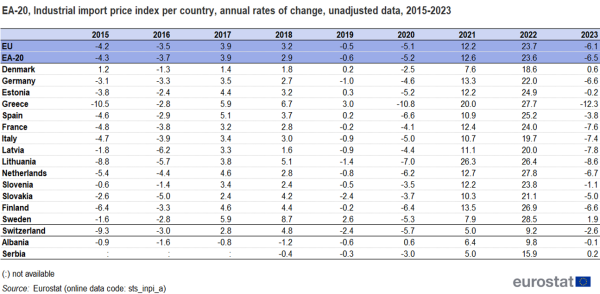
Table 2 provides an overview of the annual changes for the main industrial groupings as well as for the various manufacturing activities. Strong ups and downs in the annual prices can be observed, in particular for mining and the extraction of petroleum and gas, for coke and refined petroleum but also for basic metals.
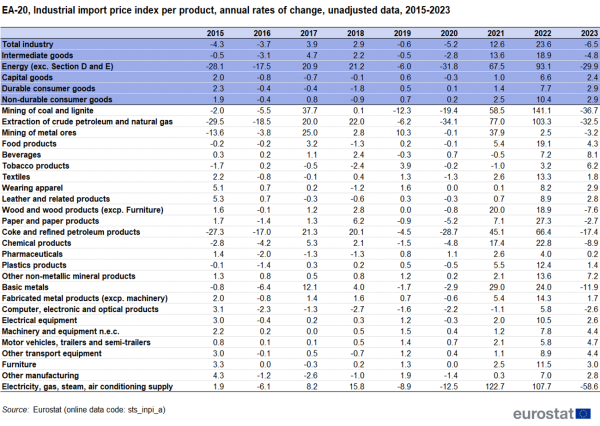
Source data for tables and graphs
Data sources
The obligation to transmit import price data to Eurostat was introduced in 2005 by Regulation (EC) No 1158/2005of 6 July 2005. The need for this indicator arose in particular in the context of the European Monetary Union. Industrial import price indices became available in 2007. Most series start with the year 2006. The current legal base are the European business statistics regulation 2019/2152 and the Commission implementing regulation 2020/1197.
The import price indices cover most mining activities and a large number of manufactured products at the 2-digit level of the NACE Rev. 2. The index is calculated on the basis of the Statistical classification of products by activity (CPA). Some product groups are however excluded (such as nuclear products, weapons, ships and aircrafts, printing and some repair services, see Table 2).
Import prices in short-term statistics are defined as follows, they:
- include cost, insurance and freight at the national border of the importing country, but not duties or import taxes;
- are actual transaction prices (not list prices) including e.g. discounts;
- are measured in the currency of the importing country. Transactions in other currencies have to be converted (this implies that the import price index is affected by exchange rate fluctuations);
- must take into account all price determining qualities of the imported products (e.g. service and guarantee conditions, included transport costs etc.);
- are recorded when ownership is transferred and the index should reflect the average prices during the reference period (month).
The data in this article were calculated with 2015 as the base year (=100). As of March 2024 short-term statistics data use the base year 2021.
Context
The industrial import prices index shows the development of prices of goods imported by enterprises which are used as intermediate products in their production process, as capital goods or as goods to be resold to consumers. The development of the index is used to forecast the development of other prices notably for domestic goods. The index is an important tool for the European Central Bank and the national central banks for monitoring and analysing inflationary developments. Industrial import prices are part of the so-called 'Principal European Economic Indicators (PEEI)' which are used to monitor and steer economic and monetary policies in the EU and in the euro area.
The industrial import price index is not the only statistical indicator which provides information on the price developments of imported goods. Unit value indices (UVIs) are calculated directly from international trade data. In principle, they are simply the total value of imports of a product, divided by the total amount imported (for most products this is measured in weight). UVIs have a long history, and long-time series are available. One of the key features of UVIs is the level of detail. Elementary UVIs can be calculated for around 10 000 products, based on the most detailed level of the combined nomenclature used for classifying international trade. UVIs record price changes which are not purely a result of an evolution of prices but which are also due to quality changes and change in the mix of products. Industrial import prices, while not as detailed as UVIs, are adjusted for quality changes and allow a more precise identification of inflationary pressures stemming from import prices.
Direct access to
- Industry (t_sts_ind)
- Industry import prices index (t_sts_ind_impi)
- Industry (sts_ind)
- Industry import prices index (sts_ind_impi)